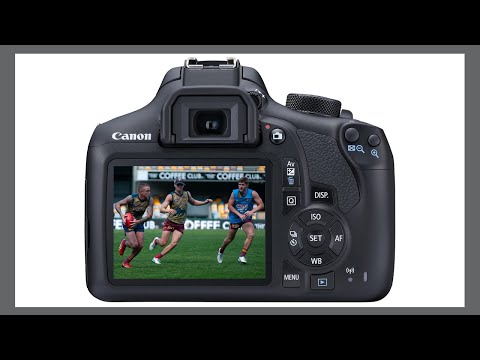What Are the Best Camera Settings for Sports Photography?
Contents
Check out these tips for what camera settings to use when shooting sports photography, whether you’re photographing a game, a match, or another type of sporting event.
Checkout this video:
Camera Settings for Sports Photography
If you’re photographing a sporting event, there are a few things you’ll want to keep in mind in terms of camera settings. First, you’ll want to make sure your shutter speed is fast enough to freeze the action. You’ll also want to make sure your ISO is not too high, as this can cause your photos to be grainy. And finally, you’ll want to make sure you have a good amount of light so that your photos are properly exposed.
shutter speed
In sports photography, you are looking to freeze the action. This means that you will need to have a fast shutter speed. A general rule of thumb is that your shutter speed should be equal to or faster than 1/1000th of a second. However, this will vary depending on the sport you are photographing and the equipment you are using.
For example, if you are photographing a baseball game, you may be able to get away with a slower shutter speed because the players are not moving as fast. On the other hand, if you are photographing a race car, you will need a much faster shutter speed to freeze the action.
Another factor to consider is the focal length of your lens. The longer the focal length, the faster your shutter speed will need to be. This is because the longer focal length magnifies the movement of your subject.
Here are some general guidelines for choosing the right shutter speed for sports photography:
-Baseball: 1/250th of a second
-Basketball: 1/500th of a second
-Golf: 1/1000th of a second
-Racing: 1/1000th of a second or faster
-Soccer: 1/250th of a second
aperture
In sports photography, one of the most important settings on your camera is the aperture. This is the setting that controls how much light comes into your camera and hits the sensor. When you are taking photos of fast moving subjects, you want to make sure that your aperture is set correctly so that all of the action is in focus and there is minimal blur.
There are two main ways to control the aperture on your camera: by using the aperture priority mode or by manually setting the aperture. If you are using the aperture priority mode, you will set the aperture value and then the camera will choose the corresponding shutter speed. If you are manually setting the aperture, you will also need to set the shutter speed yourself.
When choosing an aperture value, it is important to keep in mind that a lower number corresponds to a larger opening and a higher number corresponds to a smaller opening. For example, if you are taking photos of a football game and you want to make sure that all of the action is in focus, you would want to choose a low aperture value like f/2.8 or f/4.0. On the other hand, if you are taking photos of a slow moving subjects like flowers or landscapes, you can choose a higher aperture value like f/11 or f/16.
Another thing to keep in mind when choosing an aperture value is what type of lens you are using. If you are using a kit lens with an 18-55mm range, your maximum aperture will be lower than if you were using a prime lens with an f/2.8 maximum aperture. This means that if you want to shoot at a low aperture like f/2.8, you will need to use a prime lens.
In general, most sports photographers choose an aperture value between f/2.8 and f/5.6 because this gives them enough flexibility to shoot in different lighting conditions while still being able to get all of the action in focus. However, the exact aperture value that you should choose will depend on factors like what type of sport you are photographing and what type of lenses you have available to use.
If you are just starting out in sports photography, it is probably best to start with an aperture value around f/5.0 or f/5.6 and then experiment from there until you find an aperture value that works well for your particular situation
ISO
The ISO is one of the three pillars of the exposure triangle along with aperture and shutter speed. In simple terms, it’s a measure of how sensitive your camera sensor is to light. A low ISO like 100 is great for bright conditions or when you want maximum image quality. But if it’s dark or you need a fast shutter speed to freeze action, you’ll need to bump up the ISO to keep your photos properly exposed.
The downside of using a higher ISO is that it can introduce graininess or “noise” into your photos. So, how do you strike a balance? For most sports photography, I recommend an ISO of 1600 or 3200. At these settings, you’ll still be able to get decent image quality while keeping your shutter speed fast enough to freeze most action. If it’s particularly dark or you need an even faster shutter speed, don’t be afraid to go even higher with your ISO.
One final note – if you are shooting JPEGS, I recommend keeping your ISO at or below 1600 to avoid excessive noise and loss of detail. For RAW files, you can push the ISO much higher without worrying about quality loss since this can be corrected in post-processing.
Action Photography
When photographing sports, you need to be able to capture the action and the feeling of the game. This can be a challenge, but with the right camera settings, you can freeze the action and capture some amazing images.
shutter speed
For sports photography, you’ll want to use a faster shutter speed to freeze the action. A good rule of thumb is to use a shutter speed that is at least 1/500th of a second, but faster is better if you have enough light. If you are using a telephoto lens, you may need to use an even faster shutter speed to prevent camera shake from blurring your photos.
You can also experiment with different shutter speeds to create different effects. Slower shutter speeds will blur the action and can give your photos an artistic look. Faster shutter speeds will freeze the action and can give your photos a more serious look.
aperture
Photography has come a long way since it was first invented. Today, we have cameras that can capture images in ways that we never thought possible. One area that has seen a lot of advancements is sports photography. Sports photography is all about capturing action shots of athletes in motion. This can be a difficult task, but with the right camera settings, it is possible to get some amazing results.
There are a few different things that you will need to consider when setting up your camera for sports photography. The first is the shutter speed. You will want to use a fast shutter speed so that you can freeze the action. A good rule of thumb is to use a shutter speed of 1/500th of a second or faster. This will ensure that your images are sharp and free of blur.
Next, you will need to consider the aperture. The aperture is the amount of light that is let into the camera when taking a picture. For sports photography, you will want to use a large aperture so that more light can enter the camera. This will help to freeze the action and give you sharper images. A good rule of thumb is to use an aperture of f/8 or higher.
The final thing to consider is the ISO setting on your camera. The ISO setting determines how sensitive your camera sensor is to light. For sports photography, you will want to use a low ISO setting so that there is less noise in your images. A good rule of thumb is to use an ISO setting of 400 or lower.
By following these tips, you should be able to get some great results from your sports photography endeavors!
ISO
The ISO setting on your camera controls how sensitive it is to light. In general, the lower the ISO setting, the less sensitive it is to light, and the finer the grain in your photo will be. The higher the ISO setting, the more sensitive it is to light, and the grainier your photo will be.
For action photography, you’ll want to use a low ISO setting in order to minimize graininess and maximize detail. A good starting point is ISO 100 or 200; if you need to go higher due to low light conditions, try not to go above ISO 800.
Low-Light Photography
When shooting in low light, it is important to increase your camera’s ISO. Doing this will allow your camera to capture more light, resulting in less blur. You will also want to use a faster shutter speed to freeze the action. A tripod can also be helpful in low-light situations.
shutter speed
Shutter speed is one of the three pillars of photography, along with aperture and ISO. It is a measure of the amount of time that your camera’s sensor is exposed to light. A fast shutter speed means a short exposure time, while a slow shutter speed means a long exposure time.
The amount of light that reaches your camera’s sensor depends on three things: the aperture, the shutter speed, and the ISO. The aperture is the size of the hole in your lens that lets light in. The shutter speed is how long your camera’s sensor is exposed to light. The ISO is how sensitive your camera’s sensor is to light.
Your camera’s shutter speed can be set to any value from 30 seconds to 1/8000th of a second. A fast shutter speed will freeze action, while a slow shutter speed will blur it. A very slow shutter speed can even turn moving objects into streaks of color.
aperture
Aperture is one of the three pillars of the exposure triangle along with ISO and shutter speed. It is a measure of how much light your lens lets in when taking a photo. Aperture is typically given as an f-stop (written as “f/” followed by a number) and the lower the number, the wider the aperture and the more light that will be let in. For example, f/2.8 is a wider aperture than f/5.6.
Wider apertures like f/2.8 are great for low-light photography because they let in more light. However, they also have shallower depth of field which means that less of the image will be in focus. This can be desirable for portraits where you want to blur the background but might not be ideal for sports photography where you need everything to be sharp and in focus.
Narrower apertures like f/5.6 will let in less light but have greater depth of field so more of the image will be in focus. This makes them better for sports photography but can make it more difficult to take photos in low-light conditions.
ISO
All digital cameras have an ISO setting, which denotes how sensitive the sensor is to light. The lower the number, the less sensitive it is, while a higher number indicates a more sensitive sensor. In low light, you’ll need to increase your ISO to make up for the lack of light, but be aware that doing so will also introduce more digital noise into your images.
The best camera settings for sports photography in low light depend on a variety of factors, including the subject matter, the amount of available light, and your personal preferences. Experiment with different settings to see what works best for you.
Some things to keep in mind when photographing in low light:
– Use a tripod or monopod to keep your camera steady.
– Use a faster shutter speed to freeze action.
– Use a wider aperture (lower f-stop number) to let in more light.
– Use a higher ISO setting to make up for the lack of light.







